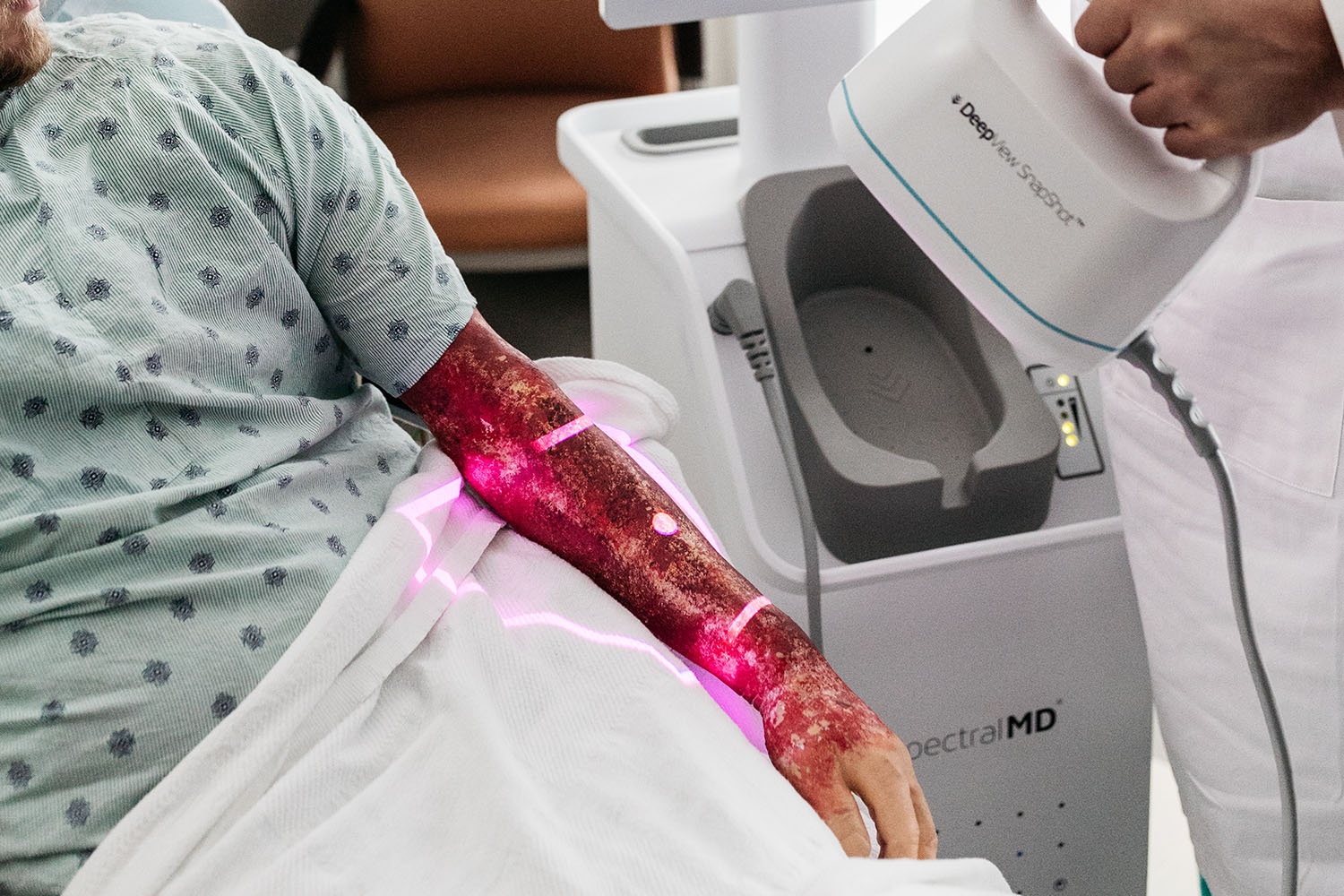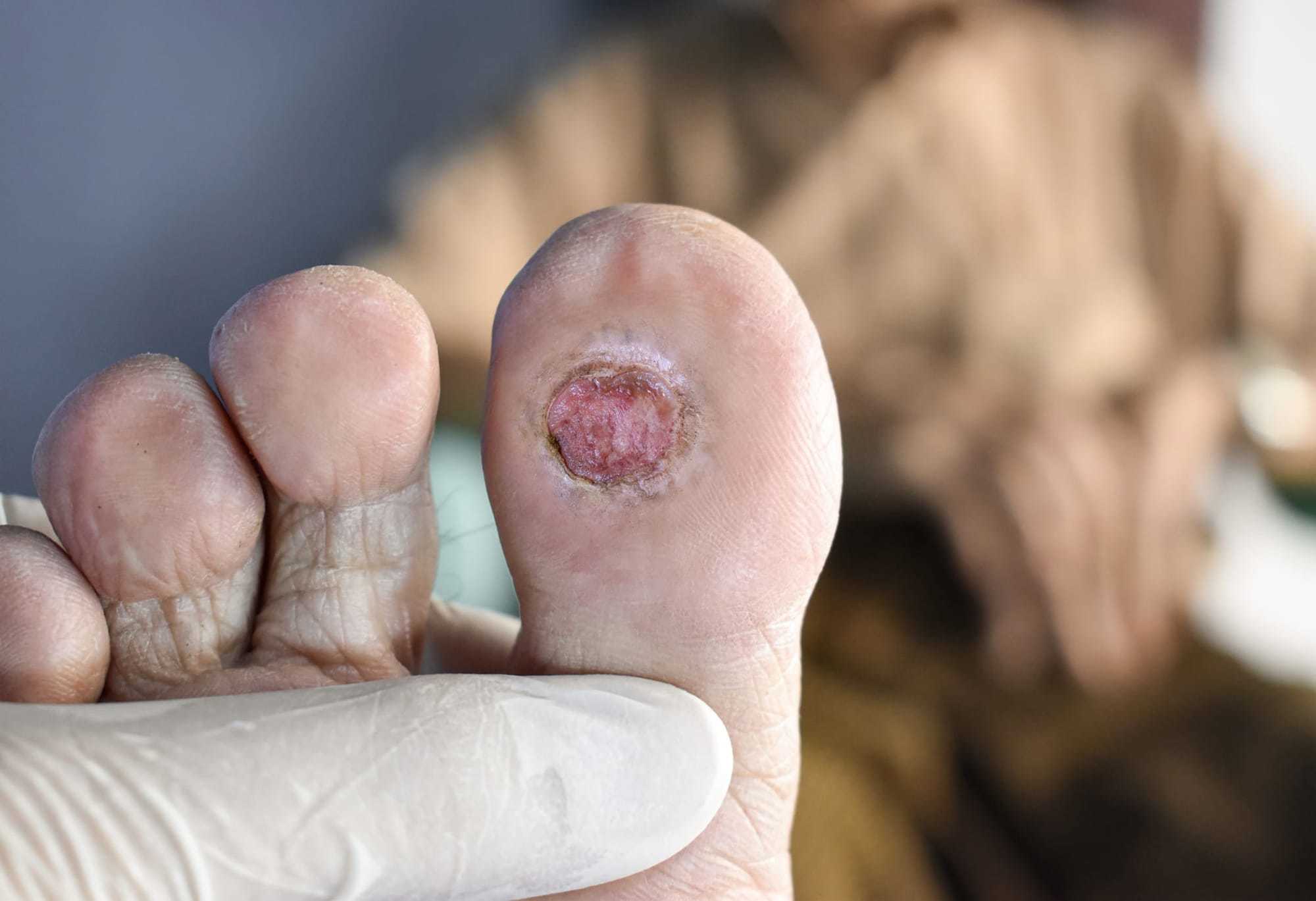Diabetic foot ulcers are a prevalent and serious complication affecting approximately 15% of individuals with diabetes during their lifetime. These ulcers can lead to severe consequences, including infections, hospitalizations, and even amputations, significantly impacting patients’ quality of life and increasing healthcare costs. Understanding the mechanisms behind the development of diabetic foot ulcers is crucial for effective management and prevention. The primary factors contributing to these ulcers include peripheral neuropathy, peripheral arterial disease, and foot deformities. Each of these conditions plays a role in the formation and exacerbation of ulcers, underscoring the importance of early detection and comprehensive treatment. Regular foot examinations by clinicians, focusing on skin inspection, vascular assessment, and neurological testing, are essential in identifying high-risk patients. Implementing prompt and multidisciplinary treatment strategies, such as wound care, offloading pressure, infection control, and optimal blood glucose management, is vital. This approach minimizes complications, promotes healing, and ultimately improves patient outcomes.
Introduction to Diabetic Foot Ulcers
Diabetic foot ulcers are a significant complication for individuals with diabetes, affecting approximately 15% of this population during their lifetime. These ulcers lead to severe consequences, including infections, hospitalization, and amputation, significantly impacting patients’ quality of life and increasing healthcare costs. Understanding the development of diabetic foot ulcers is crucial for effective management.
Development of Diabetic Foot Ulcers:
- Peripheral Neuropathy: This condition results in a loss of sensation in the feet, preventing patients from feeling pain or pressure from injuries.
- Peripheral Arterial Disease: Reduced blood flow impairs wound healing and increases the risk of infection.
- Foot Deformities: Altered biomechanics and structural abnormalities contribute to increased pressure points, causing skin breakdown.
Importance of Early Detection and Treatment:
Early detection of diabetic foot ulcers is critical to prevent severe complications. Clinicians should perform regular foot examinations, focusing on identifying high-risk patients. Key aspects include:
- Skin Inspection: Look for signs of redness, swelling, calluses, or blisters.
- Vascular Assessment: Evaluate pulses, capillary refill time, and ankle-brachial index to assess blood flow.
- Neurological Examination: Use monofilament testing and vibration perception to detect neuropathy.
Prompt treatment involves a multidisciplinary approach:
- Wound Care: Clean and debride ulcers to prevent infection.
- Offloading: Use specialized footwear or orthotic devices to reduce pressure on the ulcerated area.
- Infection Control: Prescribe appropriate antibiotics for infected wounds.
- Blood Glucose Management: Maintain optimal glycemic control to enhance wound healing.
In summary, diabetic foot ulcers are prevalent and pose serious risks for individuals with diabetes. They develop due to a combination of neuropathy, poor circulation, and foot deformities. Early detection through regular foot examinations and comprehensive management involving wound care, pressure offloading, infection control, and blood glucose regulation is essential. This approach minimizes complications, promotes healing, and improves patient outcomes.

More about Deepview
Learn more about our DeepView® technology
Request a Demo
Looking to learn more about DeepView® technology, or eager to see it in action?
What is Diabetic Foot Ulcer Debridement?
Debridement, the process of removing dead or infected tissue from a wound, is essential in treating diabetic foot ulcers. In patients with diabetes, effective debridement is crucial to promote healing and prevent complications. Various debridement methods exist, each serving a specific purpose based on the wound’s condition and patient needs.
Role of Debridement in Diabetic Foot Ulcer Treatment:
- Promotes Healing: By removing necrotic tissue, debridement reduces bacterial load and inflammation, creating a conducive environment for new tissue growth.
- Prevents Infection: Debridement eliminates potential sites for bacterial colonization, lowering the risk of severe infections and subsequent complications.
- Enhances Assessment: Clear visualization of the wound bed allows accurate evaluation of the ulcer’s depth and severity, aiding in tailored treatment planning.
Surgical Debridement
Surgical debridement is a procedure that involves the precise removal of necrotic, infected, or non-viable tissue from a wound using instruments such as scalpels, scissors, or curettes. For patients with diabetes, especially those with diabetic foot ulcers, surgical debridement is often essential to facilitate healing and prevent further complications. This technique is typically performed in a controlled, sterile environment to ensure the best possible outcomes.
Benefits of Surgical Debridement:
- Rapid Removal of Necrotic Tissue: Surgical debridement allows for the immediate and thorough excision of dead tissue, reducing bacterial load and infection risk.
- Enhanced Healing Environment: By exposing healthy tissue, this procedure promotes the formation of granulation tissue, accelerating the healing process.
- Improved Wound Assessment: Clearing away necrotic material provides a clear view of the wound bed, enabling accurate assessment of the ulcer’s depth and extent.
- Prevention of Complications: Timely debridement can prevent the progression of infection, potentially avoiding more severe outcomes like sepsis or the need for amputation.
Risks of Surgical Debridement:
- Pain and Discomfort: The procedure can cause significant pain, requiring appropriate anesthesia and pain management.
- Bleeding: Surgical debridement may lead to bleeding, necessitating careful control and monitoring.
- Infection: Despite sterile conditions, there is a risk of introducing new infections or exacerbating existing ones.
- Tissue Damage: There is potential for unintentional damage to surrounding healthy tissue, which could complicate healing.
- Cost and Access: Surgical debridement can be resource-intensive, requiring skilled practitioners and appropriate facilities, which may limit access for some patients.
In conclusion, surgical debridement is a critical intervention for managing diabetic foot ulcers. Its benefits include rapid removal of necrotic tissue, enhanced healing, improved wound assessment, and complication prevention. However, clinicians must also consider the risks, such as pain, bleeding, infection, and potential tissue damage. Careful patient selection, thorough planning, and skilled execution are essential to maximize the benefits while minimizing the risks of this important procedure.
Autolytic Debridement
utolytic debridement is a wound care technique that leverages the body’s natural enzymatic processes to break down and remove necrotic tissue. This method is particularly beneficial for patients with diabetes who develop foot ulcers, as it creates a moist environment that promotes the body’s natural healing mechanisms. The process involves applying specialized dressings, such as hydrocolloids or hydrogels, which maintain moisture and facilitate the autolytic process.
Benefits of Autolytic Debridement:
- Minimally Invasive: This method avoids the need for surgical intervention, reducing the risk of pain and discomfort for the patient.
- Selective Tissue Removal: Autolytic debridement targets only dead tissue, preserving healthy tissue and minimizing the risk of further injury.
- Enhanced Healing Environment: By maintaining a moist wound environment, this technique promotes cellular activity and accelerates tissue regeneration.
- Reduced Infection Risk: Keeping the wound covered and moist can help prevent infection by acting as a barrier against external contaminants.
- Ease of Use: Patients can often manage autolytic debridement at home with appropriate guidance, making it a convenient option for long-term care.
Risks of Autolytic Debridement:
- Slower Process: Compared to surgical debridement, autolytic debridement takes more time to achieve the desired results, which might not be suitable for wounds needing rapid intervention.
- Potential for Infection: If not monitored closely, the moist environment can become a breeding ground for bacteria, potentially leading to infection.
- Limited Effectiveness on Severe Necrosis: This method may not be effective for wounds with extensive necrotic tissue, requiring additional or alternative debridement techniques.
- Patient Compliance: Success depends on the patient’s adherence to the treatment regimen, including regular dressing changes and monitoring for signs of infection.
In summary, autolytic debridement is an effective and minimally invasive method for managing diabetic foot ulcers. It offers numerous benefits, including selective tissue removal, enhanced healing, and reduced pain. However, clinicians must weigh these benefits against the potential risks, such as slower healing times and infection. Regular monitoring and patient education are crucial to ensure the success of this debridement technique in diabetes wound care.

More about Deepview
Learn more about our DeepView® technology
Request a Demo
Looking to learn more about DeepView® technology, or eager to see it in action?
Enzymatic Debridement
Enzymatic debridement involves applying topical agents containing proteolytic enzymes to break down and remove necrotic tissue from a wound. For patients with diabetes, particularly those suffering from foot ulcers, this method offers a controlled and selective approach to debridement. These enzymes, such as collagenase, specifically target dead tissue, facilitating its removal while sparing healthy tissue.
Benefits of Enzymatic Debridement:
- Selective Action: Enzymatic debridement precisely targets necrotic tissue, reducing the risk of damaging healthy tissue and promoting a cleaner wound bed.
- Minimally Invasive: This method is less invasive compared to surgical debridement, reducing pain and discomfort for the patient.
- Ease of Application: Topical enzymes are easy to apply and can be managed in various settings, including outpatient or home care, making it accessible for long-term management.
- Reduced Need for Anesthesia: Unlike surgical methods, enzymatic debridement typically does not require anesthesia, lowering the risk of anesthesia-related complications.
- Promotes Healing: By removing necrotic tissue, this method enhances the wound environment, encouraging granulation and epithelialization.
Risks of Enzymatic Debridement:
- Slower Process: Compared to surgical methods, enzymatic debridement can take longer to achieve the desired results, which might not be suitable for wounds requiring rapid intervention.
- Allergic Reactions: Some patients may experience allergic reactions or irritation to the enzymatic agents, necessitating close monitoring and potentially discontinuation.
- Cost: Enzymatic agents can be expensive, which might limit their accessibility for some patients.
- Potential for Infection: If not properly monitored, there is a risk of infection as the wound remains open and moist during treatment.
- Requires Regular Monitoring: Clinicians need to regularly assess the wound to ensure effective debridement and to adjust the treatment plan as necessary.
In conclusion, enzymatic debridement is an effective and minimally invasive option for managing diabetic foot ulcers. It offers benefits such as selective tissue removal, ease of use, and enhanced healing, but clinicians must also consider risks like slower treatment times, potential allergic reactions, and infection. Regular wound assessment and patient education are essential to optimize outcomes with this debridement method in diabetes care.
Mechanical Debridement
Mechanical debridement is a method used to remove necrotic tissue from a wound by applying physical force. This technique is particularly relevant for patients with diabetes who develop foot ulcers, as it helps in cleaning the wound and promoting healing. Common methods of mechanical debridement include wet-to-dry dressings, wound irrigation, and the use of specialized mechanical devices.
Benefits of Mechanical Debridement:
- Effective Removal of Necrotic Tissue: Mechanical debridement efficiently removes dead tissue and debris, helping to clean the wound bed.
- Immediate Results: Unlike some other methods, mechanical debridement provides immediate results, making it suitable for wounds requiring rapid intervention.
- Cost-Effective: This method is often less expensive compared to enzymatic or surgical debridement, making it accessible for a wider range of patients.
- Enhanced Healing Environment: By removing necrotic tissue, mechanical debridement promotes a healthier wound environment, facilitating faster healing and reducing infection risk.
Risks of Mechanical Debridement:
- Pain and Discomfort: This method can be painful, particularly when using wet-to-dry dressings, which adhere to the wound and may cause discomfort during removal.
- Damage to Healthy Tissue: Mechanical force can inadvertently remove healthy tissue along with necrotic material, potentially delaying the healing process.
- Infection Risk: If not performed correctly or under sterile conditions, mechanical debridement can introduce pathogens into the wound, increasing the risk of infection.
- Patient Tolerance: Some patients may find the procedure intolerable due to pain or discomfort, necessitating alternative debridement methods.
In conclusion, mechanical debridement is a practical method for managing diabetic foot ulcers. It offers several benefits, including effective necrotic tissue removal, immediate results, cost-effectiveness, and enhanced wound healing. However, clinicians must be mindful of the risks, such as pain, potential damage to healthy tissue, infection, and patient tolerance. Careful assessment and patient education are essential to optimize the outcomes of mechanical debridement in diabetes care.
The Importance of Professional Care in Diabetic Foot Ulcer Debridement
Professional care in diabetic foot ulcer debridement is crucial for effective wound management and patient outcomes. Patients with diabetes are at high risk for developing foot ulcers due to neuropathy and poor circulation. These ulcers require meticulous care to prevent complications such as infections, gangrene, and amputations. Professional debridement plays a key role in this care.
Importance of Professional Care:
- Accurate Diagnosis: Clinicians can accurately assess the wound, determining the extent of necrosis and the appropriate debridement method.
- Personalized Treatment Plans: Professionals tailor debridement techniques to individual patient needs, choosing between surgical, autolytic, enzymatic, or mechanical methods based on the wound’s characteristics.
- Infection Control: Expert care ensures that debridement is performed under sterile conditions, reducing the risk of infection.
- Comprehensive Monitoring: Regular follow-up by healthcare providers allows for continuous monitoring of the wound’s progress, making necessary adjustments to the treatment plan.
- Pain Management: Clinicians can provide appropriate anesthesia or pain relief measures during and after the debridement procedure, enhancing patient comfort.
- Patient Education: Educating patients about foot care, the importance of glycemic control, and signs of complications helps in preventing recurrence and promoting healing.
- Multidisciplinary Approach: Professional care often involves a team of specialists, including podiatrists, endocrinologists, and wound care nurses, ensuring comprehensive management of the patient’s diabetes and foot health.
Benefits of Professional Care:
- Enhanced Healing: Professional debridement removes necrotic tissue efficiently, promoting a healthier wound environment and faster healing.
- Reduced Complications: By preventing infection and further tissue damage, professional care lowers the risk of severe complications.
- Improved Quality of Life: Effective management of foot ulcers through professional care reduces pain, improves mobility, and enhances overall quality of life for patients with diabetes.
In conclusion, professional care in diabetic foot ulcer debridement is essential for accurate diagnosis, effective treatment, and prevention of complications. Clinicians must provide personalized care, monitor progress, manage pain, and educate patients to optimize outcomes and improve the quality of life for individuals with diabetes.

More about Deepview
Learn more about our DeepView® technology
Request a Demo
Looking to learn more about DeepView® technology, or eager to see it in action?



